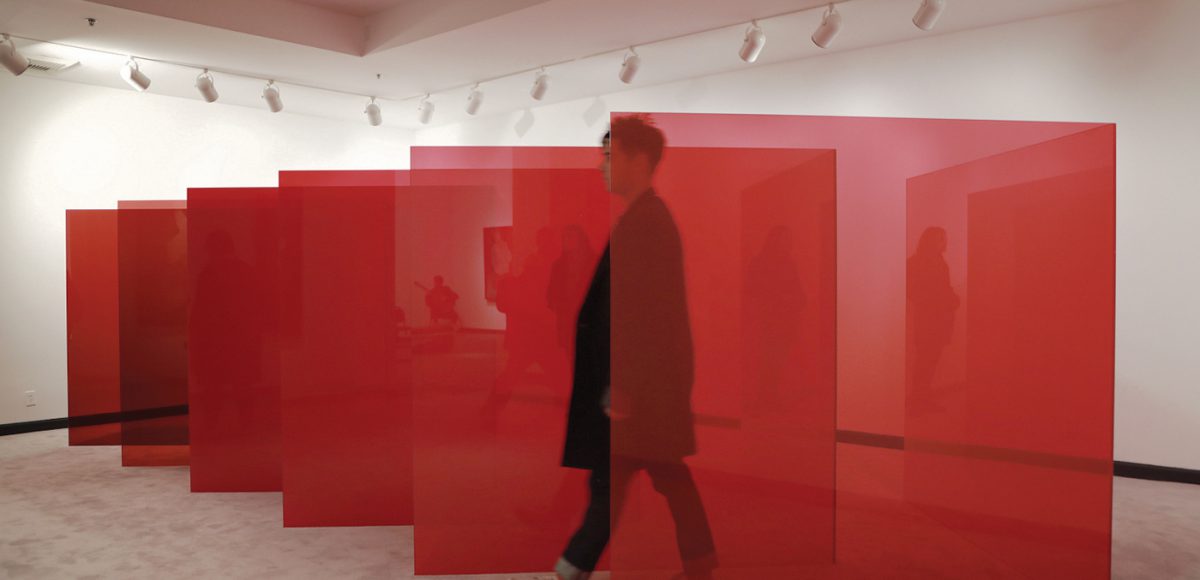January 21-April 2, 2017
If a single color captures the essence of the Pacific Ocean, it would have to be blue. The color of the daytime sea and its echoing counterpart sky, blue, has been central to iconic works on the theme by artists like Ed Ruscha and David Hockney, whose imagery is often rooted in a love affair with the classic leisure motifs of coastal Southern California. It’s surprising then, that the color red predominates in Larry Bell’s captivating recent series of multimedia works and sculpture at the Frederick R. Weisman Museum. Granted, Malibu is the setting for spectacular red-hued sunsets that blaze over the western horizon. Perhaps channeling those sunsets, Bell’s homage to Malibu is bathed in a red glow, starting with the large-scale immersive laminated glass sculpture Pacific Red II (2017, laminated glass 12 6 x 6 foot panels), from which the exhibit borrows its name. Created in the custom-built vacuum coating machine Bell calls “The Tank,” which applies thin films to the artist’s large-scale glass panels, the piece is one of the most recent iterations of his Standing Walls series. Poised at the entryway, the piece set the stage with its three connected rectangular shapes, a sort of walk-through maze exploring the optical and reflective properties of red glass.

Larry Bell
Pacific Red, Installation View
Photo by Eric Minh Swenson
In a subtle way, the reflective shadows cast from his Light Knot sculptures (2013-2016) — curved metallic kinetic polyester forms suspended from the ceiling— and the resplendent Church Studies (2014-2015), a series of mixed-media works on red Hiromi paper, suggest something of the Pacific in their recurring sinuous lines, which undulate like waves. The flowing lines in the works on paper also suggest silhouettes of the female figure. In fact, these curvilinear shapes are derived from the outlines of guitars. The two-dimensional works on paper are actually collaged, although seam- lessly so. Applying his trademark vacuum tank to a process the artist calls physical vapor deposition, Bell is able to meld various materials under low pressure to render a flat, smooth surface.
In the mezzanine gallery, a mini-historical survey of the artist’s oeuvre, going back to 1959, places the newer work in the larger context of Bell’s evolution as a sculptor, painter and multimedia artist. His early paintings followed the tradition of Abstract Expressionism, as in Untitled (1959, Oil on canvas, 39.5 x 39.5 inches). In the 1960s, Bell experimented with new materials in his work, like pieces of glass from a Burbank frame shop where he worked part-time while studying at Chouinard Art Institute. His investigations into reflective, translucent and transparent media led to the shadow boxes or ghost boxes also represented in this exhibit, and eventually the more recent cube sculptures like Cube 12 (2006, Coated glass, 15 x 15 x 15 inches) and Early and Late (2008, Coated glass, 20 x 20 x 20 inches). These pieces are mounted on transparent pedestals so they can be looked at, and through, from numerous vantage points, presenting a constantly fluctuating range of visual effects depending on where the light hits.
Although Bell has lived and worked part-time in Taos, New Mexico, since the 1960s, he still maintains a studio in Venice, California. Bell is an LA art world luminary. As such, this survey was something of a homecoming (and given the theme, it was fitting that Bell showed up for the well-attended opening decked out in a red jacket). Viewed in its entirety, Pacific Red is a cohesive and elegant orchestration of color, form and light. One of the founders of the California Light and Space Movement, Bell has continued to investigate, orchestrate and portray the intriguing, dynamic and infinite properties of light and its interplay with color, surface, form and the surrounding environment.





